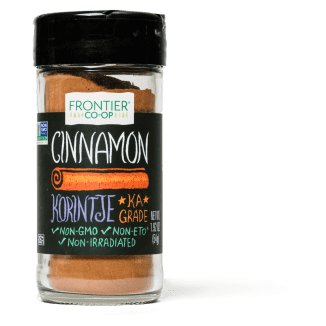Few spices feel as familiar as ground cinnamon: We swirl it into oatmeal; sprinkle it on top of lattes; bake it into pies, cakes, and cookies; and even add it to savory dishes. But when it comes to shopping for cinnamon, the choices sound exotic. Instead of picking up simple “ground cinnamon,” you can choose from among bottles specifying “Vietnamese” or even “Saigon” on the label. Such cinnamons also command a higher price—up to about $4.00 per ounce, compared with as little as $0.90 per ounce for those with generic labeling. Does origin really matter, or is it just a clever marketing tool?
To find out, we rounded up eight cinnamons, most nationally available in supermarkets and one purchased online from the spice purveyor Penzeys. Half the products were Vietnamese cinnamon. The other half didn’t specify origin on their labels, but we confirmed with manufacturers that they all hailed from Indonesia, the source for most generic cinnamon sold in this country. Tasters sampled the products stirred into chilled rice pudding, baked into cinnamon rolls, and sprinkled and baked on cinnamon-sugar pita chips.

Does origin really matter, or is it just a clever marketing tool?


It took one test—the rice pudding tasting—to determine that cinnamons are noticeably different, mainly when it comes to heat. Some were markedly spicy (a few even bordered on too intense), while the others had more-tempered heat that allowed hints of sweetness and clove to come through. When we compared comments to products, we discovered that origin does matter: The Vietnamese cinnamons all fell on the spicier end of the spectrum, while the Indonesian cinnamons were milder. And there were tasters who championed each style.
We looked deeper into cinnamon production and learned that “cinnamon” is actually an umbrella term for several different species of evergreen trees in the genus Cinnamomum. Moreover, the species grown in Vietnam is different from the species grown in Indonesia. Vietnamese growers cultivate Cinnamomum loureiroi, which is naturally higher in the volatile oils that provide heat and carry cinnamon’s trademark flavors than the Cinnamomum burmannii grown in Indonesia. A less common third type, Cinnamomum verum, is grown in Sri Lanka. Another species (Cinnamomum cassia) grown in China is mainly imported to the United States in the form of oils for flavoring in food manufacturing.

It took one test—the rice pudding tasting—to determine that cinnamons are noticeably different, mainly when it comes to heat.
The age of the bark at harvesting also affects the amount of volatile oils. Harvesting entails stripping the exterior bark from the tree and then scraping its interior into strips, or quills, that are then sun-dried and ground. Older trees contain the most oils. Indonesian cinnamon typically comes from the bark of trees that are less than 10 years old, while Vietnamese cinnamon is often harvested from trees between 20 and 25 years old. Lab analysis confirmed these differences: The Vietnamese cinnamons in our tasting contained between 4.5 and 5.3 percent volatile oils, while the Indonesian cinnamons contained 1.9 to 2.8 percent.
Three Cinnamons, Oceans Apart

Most of the cinnamon sold in supermarkets is harvested from the bark of trees grown in Indonesia and Vietnam. But in many parts of the world, Ceylon cinnamon, or “true” cinnamon, which is grown primarily in Sri Lanka, is more common. When we pitted three Ceylon cinnamons against our favorite Indonesian cinnamon, tasters easily singled out the Ceylon products, finding them milder and more subtle. Lab tests backed this up, confirming that all of the Ceylon cinnamons had lower percentages of key volatile oils than did our favorite Indonesian product. In general, our tasters preferred the bolder, spicier flavor profile of Indonesian- and Vietnamese-grown cinnamons, but if you like a floral, more delicate flavor, Ceylon (our favorite is by Frontier) could be a good choice.
The Great Equalizer
Tasters felt the burn of many of the Vietnamese cinnamons when tasting them sprinkled on rice pudding, but that heat all but disappeared when we sampled the cinnamons baked into cinnamon rolls and on pita chips. In fact, tasters struggled to detect differences of any kind in these baked items, deeming every product acceptable except for one outlier (more on that in a minute). What had happened to the heat?

Three main chemical compounds comprise the bulk of volatile oils in cinnamon. The compound responsible for spiciness, cinnamaldehyde, is by far the most abundant of the three, but it’s also the least stable in the presence of heat. The other two compounds—eugenol and linalool—provide cinnamon’s floral, woodsy, and clove aromas, but they are present in very tiny amounts, hence the subtlety of these flavors. Some of the cinnamaldehyde and virtually all of the eugenol and linalool will be carried off by steam once the moisture in a baked good (or any cooked, moist foodstuff) starts to evaporate. Eugenol helps stabilize cinnamaldehyde, and without its protection, cinnamaldehyde will start to break down once the temperature of the food reaches 140 degrees—a temperature easily exceeded during baking. No wonder the cinnamons all tasted virtually the same in the baked applications.

And what about that outlier cinnamon that nobody really liked? Tasters singled it out for its dull flavor and musty aftertaste in all three applications. This product turned out to be an Indonesian-sourced cinnamon from Badia. The manufacturer told us that it adds 2 percent soybean oil to its cinnamon as a processing aid, which had to help explain its lingering “musty” flavor.
Baking with Cinnamon? Any Will Do
We found differences among cinnamons, mainly in terms of heat, when we sampled them stirred into chilled rice pudding. But those distinctions faded when we baked the spices in cinnamon buns and on pita chips. That’s because, of the three main volatile oils responsible for cinnamon’s flavor, the most abundant oil is spicy-tasting cinnamaldehyde, which is also the least stable in the presence of heat. So if you’re buying the spice primarily for baking, any of our recommended products will do.
Split Decision
With the exception of this one product, we found that it’s hard to go wrong with cinnamon. If you like a big, spicy flavor and use cinnamon frequently in unheated applications, we recommend springing for Penzeys Vietnamese Cinnamon Ground. It was the most expensive product in our lineup, but it also had the highest percentage of volatile oils: 5.3 percent. And while a few of the other Vietnamese cinnamons seemed to be all punch and no nuance, this product offered an array of floral, earthy notes in addition to heat. But if you use cinnamon just for baking, or if you prefer a milder, sweeter cinnamon in unheated applications, stick with cheaper cinnamons that make no claim to origin. Our favorite among these cinnamons was Morton & Bassett Spices Ground Cinnamon, which had tempered heat and a complex bouquet of floral, woodsy, and earthy aromas.
- Taste swirled into chilled rice pudding
- Taste baked into cinnamon rolls
- Taste sprinkled and baked on pita chips
- Send samples to a lab to determine volatile oil content
- No origin cited on labels (an indication of Indonesia-sourced cinnamon) (if you like your cinnamon mild)
- Low percentage of volatile oils (if you like your cinnamon mild)
- Sourced from Vietnam (if you like your cinnamon spicy)
- High percentage of volatile oils (if you like your cinnamon spicy)
- No additives














